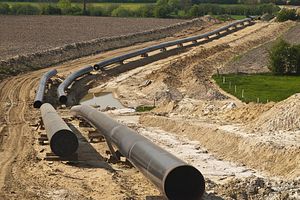The Asian Development Bank this week oversaw the signing of an investment agreement among the four partners in the much-discussed Turkmenistan-Afghanistan-India-Pakistan pipeline. The four agreed to invest an initial budget of more than $200 million.
As has been frequently discussed in these pixels, the TAPI project is impressive in its ambitions and massive in its mysteries. Last December, Turkmenistan hosted a groundbreaking ceremony and in February regional media reported that Turkmen President Gurbanguly Berdimuhamedov had told a gathering of his ministers that “topographic, engineering and survey works have been completed for the construction of TAPI.”
The recent ADB press release, however, implies otherwise:
This [the $200 million investment] includes funding for detailed engineering and route surveys, environmental and social safeguard studies, and procurement and financing activities, to enable a final investment decision, after which construction can begin. Construction is estimated to take up to 3 years.
For years TAPI has been spinning its wheels, with the partners making periodic updates and statements which are a simple simulacrum of progress.
In an interview with Reuters, Sean O’Sullivan, the Central and West Asia director general of the ADB, said that present timetables peg 2020 for completion of the pipeline, which will carry 33 billion cubic meters (bcm) of gas annually from the Galkynysh field in Turkmenistan to markets in Afghanistan, Pakistan, and India. According to Reuters, the current plans for the pipeline include an underground pipe through some of the most volatile regions in Afghanistan:
“I agree … we’re going through some of the toughest territory in Afghanistan,” said [O’Sullivan], a transaction adviser for the project.
“The challenge is there. There’s no doubt about it, but I am sure it’s doable.”
He added, “I think if it happens, it will be quite an unprecedented example of regional cooperation, particularly in a region that finds it difficult to cooperate.”
I’ve written fairly extensively on the security problems for the project, including detailing how security issues aborted TAPI’s late-1990s predecessor. Few can disagree with the overarching logic of the project–Turkmenistan has plenty of gas and Pakistan and India are starved for energy–but none of that solves or convincingly bypasses the security problems in Afghanistan.
O’Sullivan offered, in his interview with Reuters, the most open answers yet to questions regarding security and how the project will actually be completed. He commented that usually such large projects are broken up into two or three major contracts in order to attract international bidders (the World Bank, where I worked briefly in the past, also tackles large procurements in such a method). This is the standard method; it is the most cost-effective and designed to bring in the most competent firms to handle massive projects. But O’Sullivan said, “We want to split it [TAPI] up into smaller parts that Afghan contractors are capable of doing, and hope to reduce the security risk by doing so.”
This is a more non-traditional scheme. Local contractors might be, in a social context, more acceptable but are not necessarily the most cost-effective or the most competent. A district in Helmand province may only have a handful–if that–of companies equipped to do the work (and acceptable to whomever holds the magic keys to security). This method of contract slicing opens the door for inflation of costs. Then there’s the issue of corruption. Yes, it happens at both the international and local scales, but corruption has been a persistent problem in construction projects in Afghanistan and cannot be ignored (Just ask SIGAR).
“TAPI will unlock economic opportunities, transform infrastructure, diversify the energy market for Turkmenistan, and enhance energy security for the region,” O’Sullivan says in the ADB press release. These things remain true, but TAPI’s predicted benefits don’t make the project any more “doable.”

































